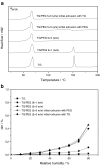Two-step solid lipid extrusion as a process to modify dissolution behavior
- PMID: 20309654
- PMCID: PMC2850486
- DOI: 10.1208/s12249-010-9395-y
Two-step solid lipid extrusion as a process to modify dissolution behavior
Abstract
Extrudates based on varying ratios of the triglyceride tripalmitin and the hydrophilic polymer polyethylene glycol as matrix formers were produced as oral dosage forms with controlled release characteristics. The extrudates were processed below the melting points of the excipients and contained the hydrophobic model drug chloramphenicol. The influence of the ratio of the matrix formers on drug dissolution was investigated, with an increase in the water-soluble polymer content increasing the drug release rate. In addition, the effect of varying the extrusion process on the extrudate structure and drug dissolution was investigated. Two-step extrusion was performed, which comprised an initial extrusion step of drug and one matrix component followed by milling these extrudates and a second extrusion step for the milled extrudates mixed with the second matrix component. Initial extrusion with polyethylene glycol led to increased dissolution rates, while initial extrusion with tripalmitin led to decreased dissolution rates compared to the dissolution characteristics of extrudates containing the same composition produced by one-step extrusion. Thus, two-step solid lipid extrusion can successfully be used as a process to modify the dissolution behavior of extrudates.
Figures






Similar articles
-
Dissolution from solid lipid extrudates containing release modifiers.Int J Pharm. 2011 Jun 30;412(1-2):77-84. doi: 10.1016/j.ijpharm.2011.04.010. Epub 2011 Apr 14. Int J Pharm. 2011. PMID: 21515350
-
Tailor-made dissolution profiles by extruded matrices based on lipid polyethylene glycol mixtures.J Control Release. 2009 Aug 4;137(3):211-6. doi: 10.1016/j.jconrel.2009.04.002. Epub 2009 Apr 7. J Control Release. 2009. PMID: 19358867
-
Analysis of matrix dosage forms during dissolution testing using raman microscopy.J Pharm Sci. 2011 Oct;100(10):4452-9. doi: 10.1002/jps.22609. Epub 2011 May 10. J Pharm Sci. 2011. PMID: 21560128
-
Pharmaceutical approaches to preparing pelletized dosage forms using the extrusion-spheronization process.Crit Rev Ther Drug Carrier Syst. 2007;24(1):1-40. doi: 10.1615/critrevtherdrugcarriersyst.v24.i1.10. Crit Rev Ther Drug Carrier Syst. 2007. PMID: 17430098 Review.
-
Polyethylene oxide and its controlled release properties in hydrophilic matrix tablets for oral administration.Pharm Dev Technol. 2020 Dec;25(10):1169-1187. doi: 10.1080/10837450.2020.1808015. Epub 2020 Aug 20. Pharm Dev Technol. 2020. PMID: 32772604 Review.
Cited by
-
Solvent-free melting techniques for the preparation of lipid-based solid oral formulations.Pharm Res. 2015 May;32(5):1519-45. doi: 10.1007/s11095-015-1661-y. Epub 2015 Mar 19. Pharm Res. 2015. PMID: 25788447 Free PMC article. Review.
-
Chemical imaging of drug delivery systems with structured surfaces-a combined analytical approach of confocal raman microscopy and optical profilometry.AAPS J. 2013 Apr;15(2):505-10. doi: 10.1208/s12248-013-9457-7. Epub 2013 Jan 29. AAPS J. 2013. PMID: 23358922 Free PMC article.
References
-
- Jones C, Burtan MA, Gray BN, Hodgkin J. In vitro release of cytotoxic agents from ion exchange resins. J Control Release. 1989;8:251–257. doi: 10.1016/0168-3659(89)90046-1. - DOI
MeSH terms
Substances
LinkOut - more resources
Full Text Sources

